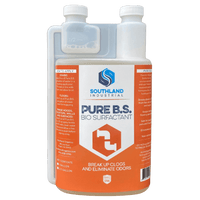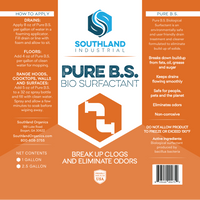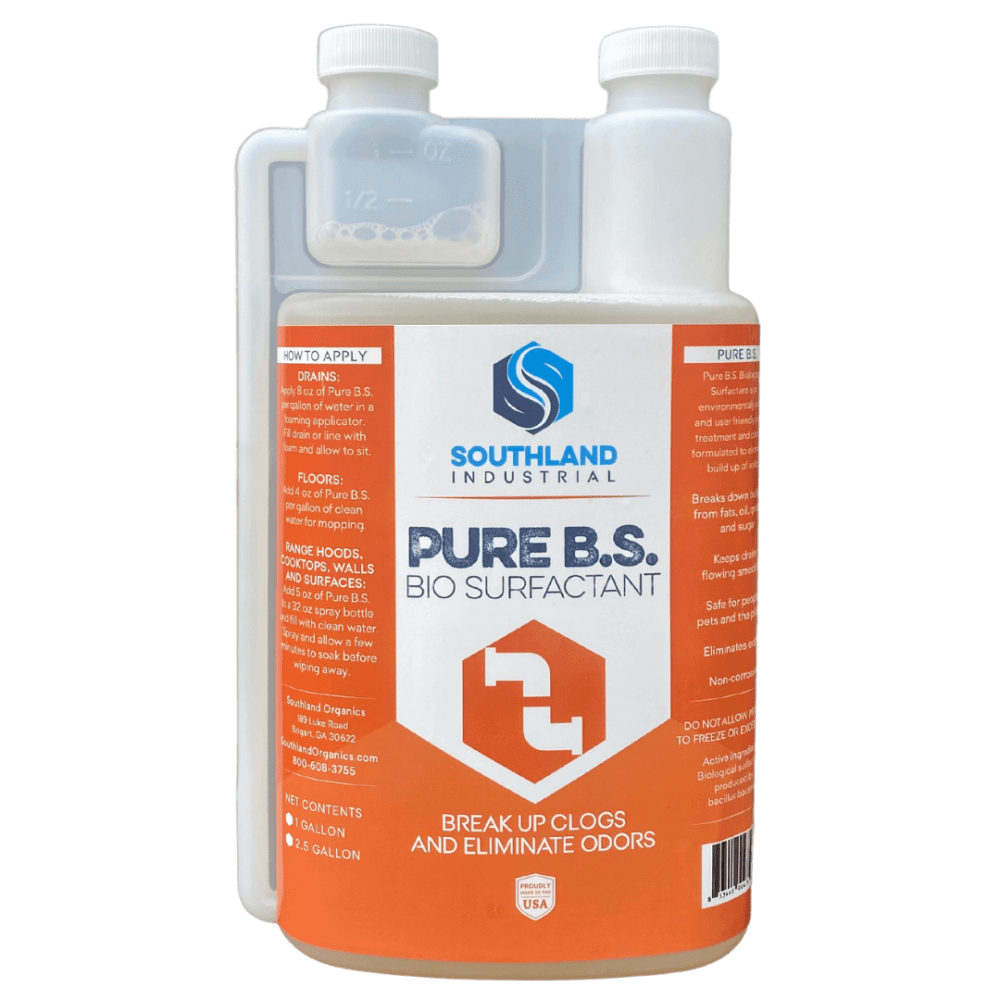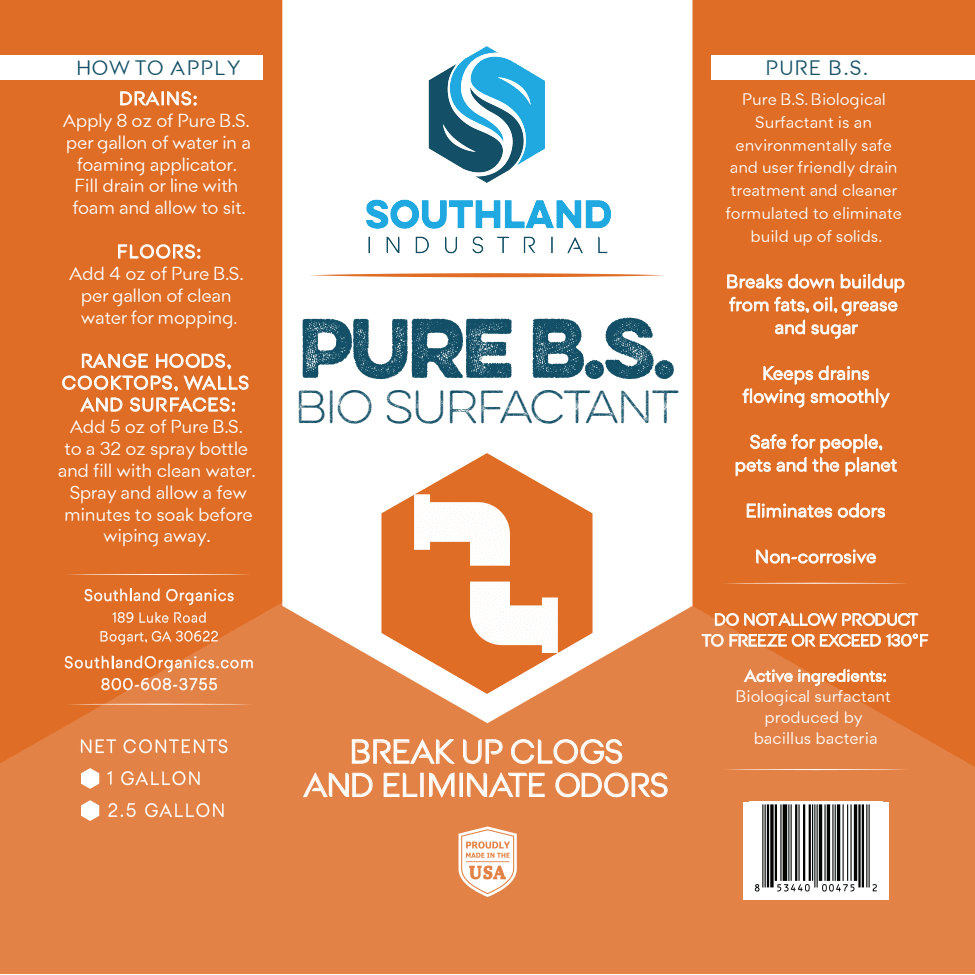Drains
Apply 1 ounce of Pure B.S. to clogged or fly-ridden drains and let soak. For best results, apply to each drain once per week.
If you're using a foaming applicator, apply 8 ounces of Pure B.S. per gallon of water. Fill drain or line with foam and allow to sit.
Floors
Add 4 ounces of Pure B.S. per gallon of clean water for mopping.
Range Hoods, Cooktops, Walls and Surfaces
Add 5 ounces of Pure B.S. to a 32-ounce spray bottle and fill with clean water.
Spray and allow a few minutes to soak before wiping away.
Pure B.S. is classified as a biosurfactant. This classification relates to surfactants produced by microbes. Like all other surfactants, Pure B.S. works by breaking surface tension, making it capable of reaching places that water can't. This makes it extremely effective in the elimination of biofilm and waste buildup.
Break Up Clogs
Pure B.S. provides a powerful and natural solution to common drain issues, using a blend of biological surfactants, soap and beneficial microbes. With regular dosage, Pure B.S. is able to avoid daily buildup of debris like fats, oils, grease and sugars to help maintain clear plumbing systems. Its biosurfactant components break down organic matter that feeds harmful microbes and drain flies in drains and pipes.
Eliminate Odor
Foul odor can often stick around long after a blockage is resolved. Pure B.S. removes existing biofilms and replaces them with proactive biofilms to fight odors and future blockages.
What are surfactants?
Surfactant is short for surface active agents. These are amphiphilic molecules, which means they have a hydrophobic, or “water-hating” tail, and a hydrophilic, or “water-loving,” tail.
Because of this unique chemistry, these amphiphilic molecules exist at the interface between oil and water. They make it possible for the two to mix by reducing surface tension. This is why you will hear surfactants referred to as “wetter than wet.” They can reach places that water can't!
Surfactants' ability to break surface tension makes them a great tool for eliminating biofilm and waste buildup. Biosurfactants, like those in Pure B.S., are simply surfactants of microbial origin.
Pure B.S. SDS
How do Surfactants work?
How to Get Rid of Drain Flies
Using a Bio Surfactant as a Natural Floor Cleaner
Pure B.S. is made of biological surfactants, soap and beneficial microbes. As a surfactant, molecular structure is the secret behind the cleaning power of Pure B.S! A surfactant is an amphiphilic molecule, which means it has a hydrophobic, or “water-hating” tail, and a hydrophilic, or “water-loving” tail.
Natural Surfactants
Some natural surfactants are derived from plants like coconut or palm. Pure B.S. comes from Bacillus bacteria. Typically, natural surfactants are better for sensitive skin than synthetic surfactants, especially in facial cleansers and body wash. Despite being more gentle, natural surfactants have similar solubilizing, emulsifying, dispersing, detergent and stabilizing properties as chemically-synthesized surfactants. Natural surfactants can still create a stable foam for cleansing formulas. As a natural non-ionic surfactant, Pure B.S. provides a potential replacement for other surfactants that are plant-based, including coco glucoside, decyl glucoside and lauryl glucoside. Typically, natural surfactants are better for sensitive skin than synthetic surfactants, especially in a facial cleanser.
Biosurfactant molecules are widely used as antioxidants and antimicrobial ingredients for their ability to reduce surface tension. Micelles are aggregations of biosurfactant molecules. The concentration at which micelles start forming is called the critical micelle concentration (CMC). The CMC determines the point at which surfactants can reduce surface tension and change substances of amphiphilic nature. In nature, these are survival mechanisms to competitively exclude other microbes from their environment.
Surfactins
One exceptionally unique type of surfactant in Pure B.S. is referred to as a surfactin. Surfactins are extremely powerful surfactants produced by strains of B. subtilis bacteria. In nature, Bacillus produce this chemical as a form of chemical warfare to occupy a space and kill competing species.
For this reason, surfactins are most commonly used as an antibiotic against species other than Bacillus. Similar substances have been shown to have antiviral as well as antifungal effects. We use this surfactin as a component in Pure B.S. to work as a powerful agent against biofilm formations.
Biosurfactant Structure
A surfactant is categorized as a biosurfactant when it is derived from microbes. A biosurfactant is made up of a hydrophilic part of a molecule and a hydrophobic part of a molecule. This is similar to the structure of synthetic surfactants.
The hydrophobic portion is composed of fatty acids that vary based on their source. Surfactants from palm will contain different fatty acids than those made by microbes. The hydrophilic portion is made of free amino acids, peptides, saccharides and alcohols, which can also vary.
The most commonly used surfactants are anionic surfactants because they tend to provide the greatest amount of foam and the strongest cleaning power. The most widely-used anionic surfactant is SLS (sodium lauryl sulfate). It can be found in health and beauty products like toothpaste, shampoo and shower gels.
Another type of surfactant is a cationic surfactant. Cationic surfactants have a positive charge that is attracted to the negative charge in hair, helping keep it smooth and reduce frizz.
The term "biosurfactant" refers to a surfactant that is of biological origin and has a specific molecular structure. With biosurfactants, the hydrophobic component is made up of fatty acids, and the hydrophilic component is made up of amino acids, peptides, (poly)saccharides or sugar alcohols.
No, Pure B.S. does not contain essential oils. Our products with essential oils are Torched All-Natural Weed Killer, Defender Natural Insecticide, SO Essentials Bug Spray and Desecticide Darkling Beetle Insecticide.
